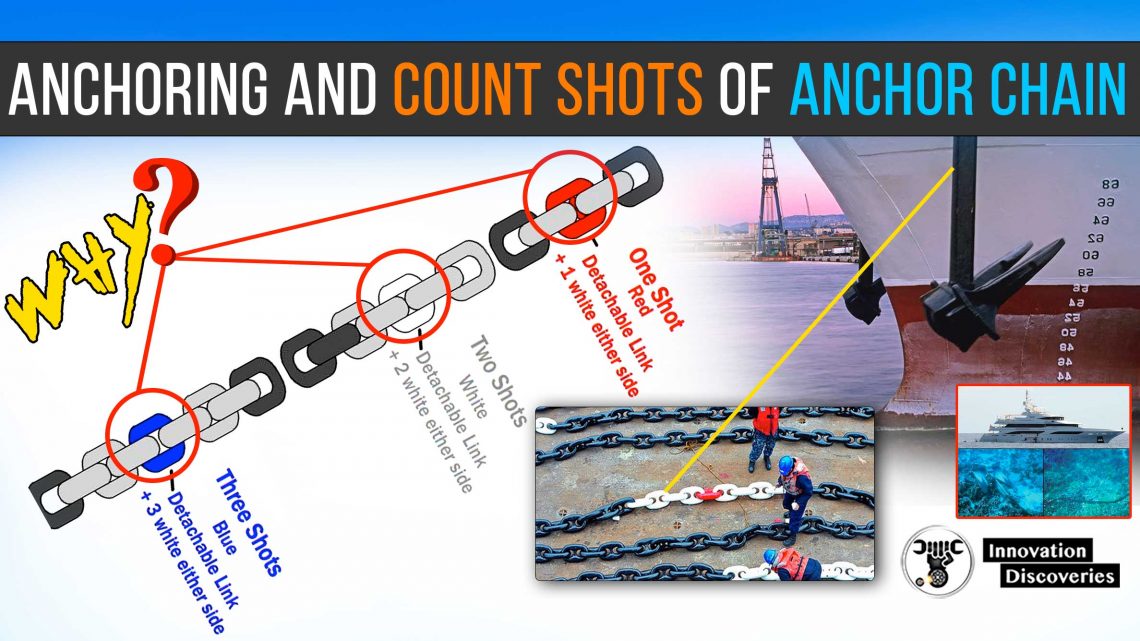
WHY DO WE ANCHOR?
- Protection of a Ship/boat from storm
- Provide rest for the crew
- Dock space not available in a harbor
- If the engine gets failure then to maintain the sustainability of the ship/boat in water an anchor gets used.
Things to look for when selecting an anchor
- Water depth
- Bottom type (clay, sand, mud, rock, boulders, weeds)
- Clay, sand, and mud provide the best anchoring substrates
- Rock shelves, boulders, and weeds are the worst substrates
- Protection from predicted winds, protection from prevailing winds and currents or tides.
- Size of anchorage, for room to swing.
ANCHOR PRINCIPLES
Two general categories of anchors:
1.Heavyweights
- Used for stationary objects like navigation buoys
2. Anchors that dig into the bottom
- Used on vessels and combine weight and ability to dig into the substrate
PARTS OF AN ANCHOR
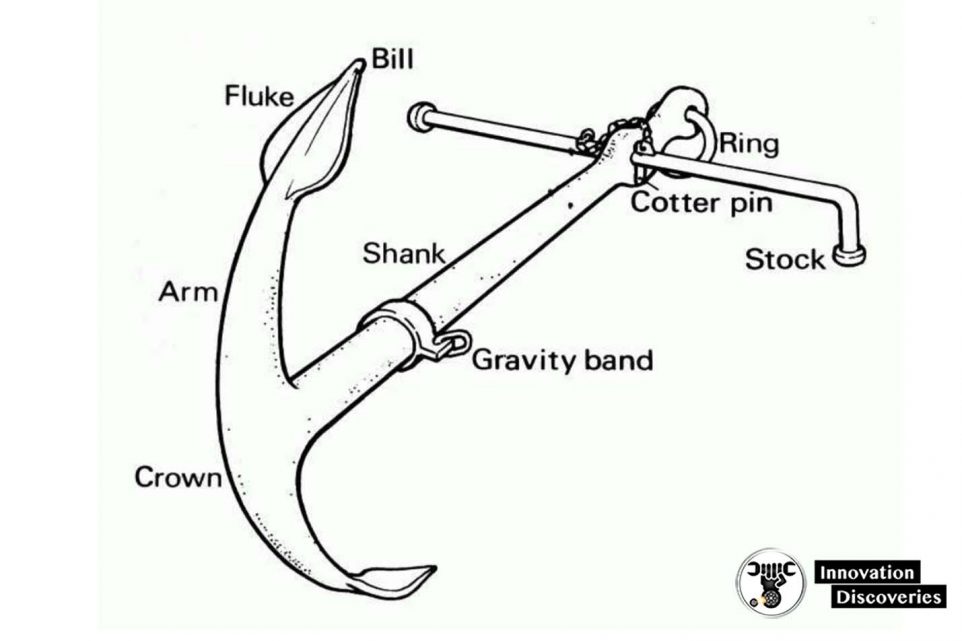
TYPES OF ANCHOR
1. A/P or Fisherman’s anchor:
- Non-burying type, with one arm penetrating the seabed and the other standing upright
- It has a good reputation for use in rock, kelp, and grass, but is unlikely to be any more effective than a good modern design, and its holding power to weight ratio is among the worst of all anchor types
- The primary weakness of the design is its ability to foul the cable over changing tides
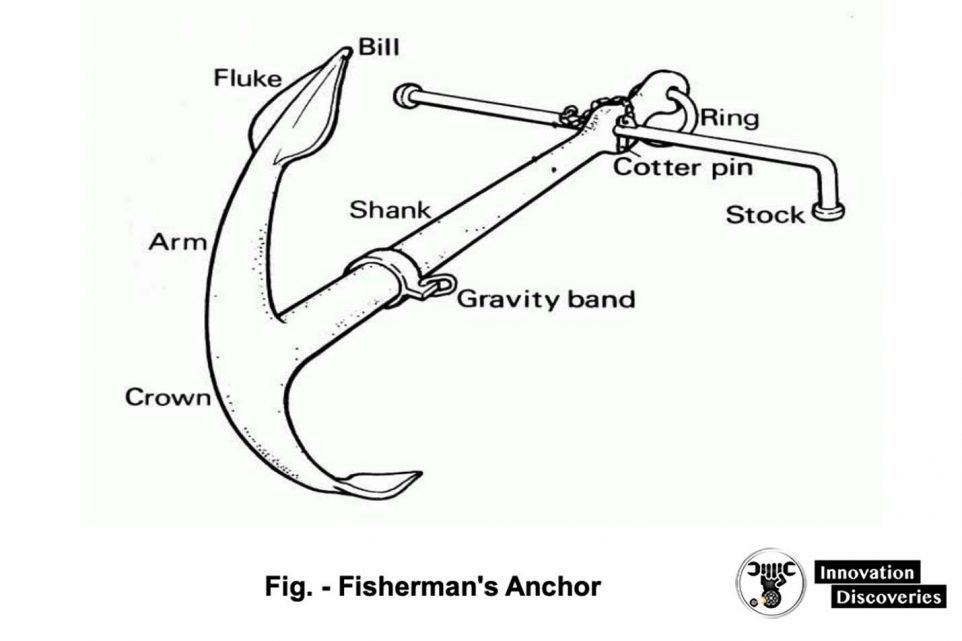
2. Danforth Anchor
- The stock is hinged so the flukes can orient toward the bottom
- The design is a burying variety, and once well set can develop an amazing amount of resistance.
- Its lightweight and compact flat design make it easy to retrieve and relatively easy to store
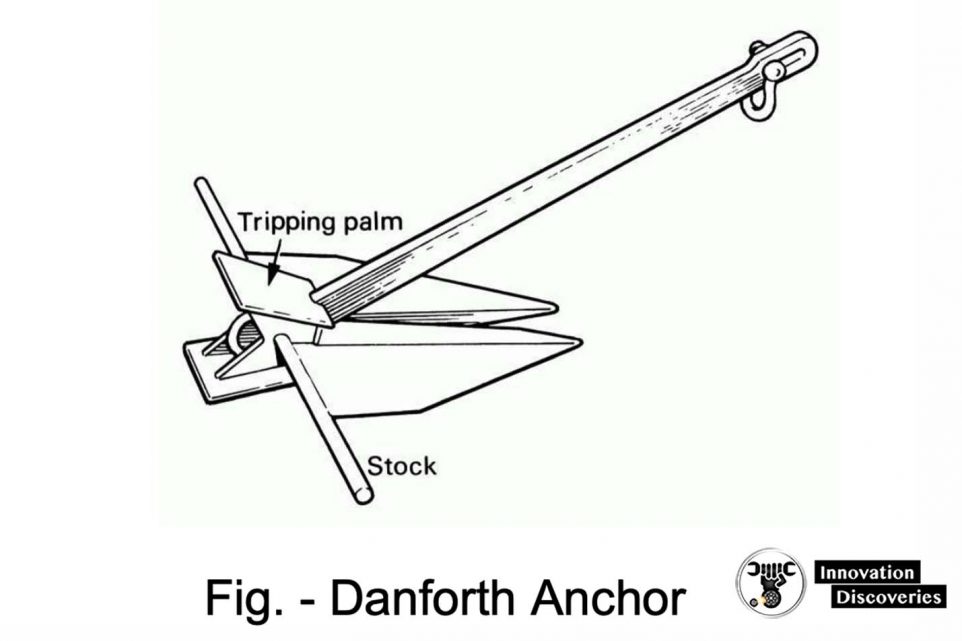
3. CQR/Plough Anchor
Generally good in all bottoms, but not exceptional in any.
It has a hinged shank, allowing the anchor to turn with direction changes rather than breaking out, and also arranged to force the point of the plough into the bottom of the anchor lands on its side.
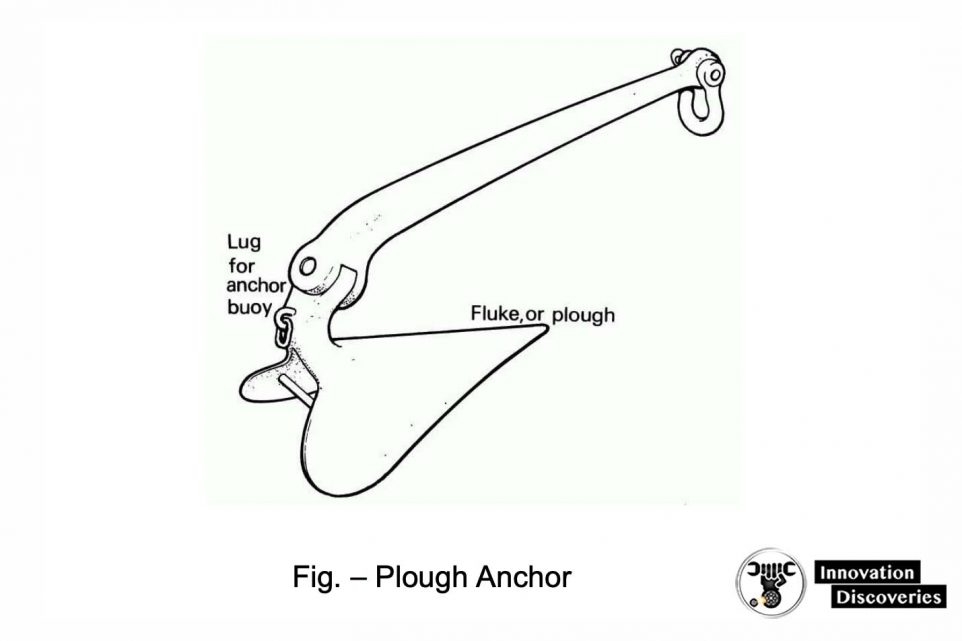
Bruce/Claw Anchor
- Claw-types set quickly in most sea-beds and although not an articulated design, they have the reputation of not breaking out with tide or wind changes, instead slowly turning in the bottom to align with the force.
- Claw types have difficulty penetrating weedy bottoms and grass.
- They offer a fairly low holding power to weight ratio and generally have to be oversized to compete with other types.
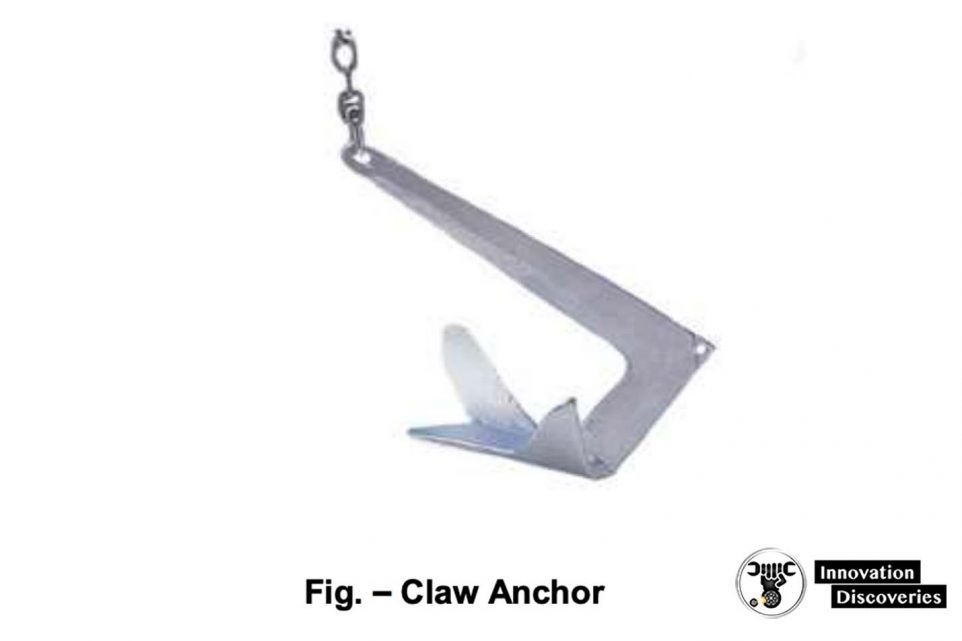
Capstans and Windlasses (They help to operate anchor from the ship/boat)
Capstan
- Used on traditional vessels
- Bars attached allowing crew members to turn the capstan
Windlass
- Pathfinder: Pawl-rack system, two handles are pumped back and forth
- Playfair: Gear system, handles are attached and wound in a circular motion
Catting the Anchor
- The process of hoisting an anchor by its ring so that it hangs at the cathead
- Anchor is unlashed from the deck
- Stock is inserted, bolted in place
- The anchor chain is overhauled and the end is brought up on deck (outboard of everything)
- The chain is shackled onto the anchor
- Shackle is moused
- Davit is rigged with a handy billy
- Anchor is raised off the deck with the handy billy and swung over the side
- Anchor is lowered with the handy billy as the slack in the chain is taken up
- Anchor is left dangling if it will be used immediately, or is lashed to the whisker stays if it will not be used.
- Catting also refers to bringing the anchor inboard
Depth Soundings
- Soundings are traditionally done with a lead line
- Electronic depth sounders send sound waves from a transducer on the hull, through the water that bounce off the bottom and back to the transducer
Lead Line
- Line with a lead weight
- Lead weight can be “armed” with something sticky (traditional tallow was used) to determine what type of bottom is in the anchorage.
- The lead line is thrown from up forward
- Lead is thrown as far forward as possible
- You should feel it hit the bottom, take up slack as the boat moves towards it
- Markings should be read when the lead line is straight up and down beside the thrower
- Do not hit people or the boat with the lead
- Face the stern when calling the readings
Reading the Lead Line
| Number of Fathoms | Markings on Lead Line |
|---|---|
| 1 | Danger, an orange mark |
| 2 | Two pieces of leather |
| 3 | Three pieces of leather |
| 4 | No marking “Deep four” |
| 5 | One piece of white sailcloth |
| 6 | No marking “Deep six” |
| 7 | One piece of red cloth |
| 8 | No Marking “Deep 8” |
| 9 | No Marking “Deep 9” |
| 10 | One knot |
| Depth in Fathoms | Call |
|---|---|
| 1 | By the mark danger |
| 1 ¼ | And a quarter danger |
| 1 ½ | And a half danger |
| 1 ¾ | Less a quarter danger |
| 2 | By the mark two |
| 2 ¼ | And a quarter two |
| 4 | Deep 4 |
| 4 ¼ | Deep 4 |
| 6 | Deep 6 |
| No bottom | No bottom at x (x is the closest fathom) |
Preparing to Drop the Anchor
- Supplies you will need
- Hammer or a Persuasion Bar if on Playfair
- Make sure the star is turning without too much force so it will spin free when needed
- Anchor ball and gash line
- T-bar (Path), Crank handle (Play)
- Flashlight if it’s dark
- Your brain and a loud voice
What are Scope Depth 3 Fathoms
Scope = Length of Anchor rode / Depth
- Scope = 9 / 3 or 3 to 1
- Scope = 21/ 3 or 7 to 1

Catenary
- An anchor rode is not just a straight link between the bow and the anchor.
- If you could swim down alongside it, you would see it start from the bow at a fairly steep angle, then slowly flatten out until it blends smoothly into the bottom.
- Having a lot of sag in the rode reduces shock loads and helps keep the anchor dug in by reducing the angle between the rode and anchor.
How do you know how much anchor rode to put out?
- Stopping for a swim – 3:1 scope
- Stopping for the day – 5:1 scope
- Anchoring for the night – 7:1 scope
- These are rough estimates
- If you were expecting a storm with high winds you might want a 10:1 scope
- What should you be concerned about when you have that much scope?
Chain Markings
| Fathoms | Marking |
|---|---|
| One | One red mark |
| Five | One white mark |
| Ten | One black mark |
| Fifty | One blue mark |
What would 67 fathoms be?
Dropping the Anchor
- As you come into an anchorage your watch officer will yell “Stand by up forward”
- The bosun or PO will yell “Aye standing by”
- When the watch officer and Captain have decided where to anchor they will yell “Let go and veer to x fathoms”
- Bosun will respond “Aye x fathoms”
- The star will be loosened all the way allowing the gypsy to spin
- The anchor will drop very quickly until it hits the bottom
- Do not have hands or feet in the way, they will get mangled
Anchoring
- Often, the POs job is to watch over the side as the chain goes out, counting the markings until the desired mark has been reached.
- The Bosun will slow the release of the chain as you get closer to the desired mark
- The bosun will yell “ ‘x’ at the water”
- If that is the desired mark the Watch officer will yell “That’s well, dog her there”
- Bosun will reply “Dogging her there”
More on Anchoring
- The Watch officer will often put the engine in reverse to “set” the anchor, and dig it in
- Set the Anchor ball once the “Dog her there” order is given.
The ball is raised on the jib halyard or forestays’l halyard, it should sit just below the course yard so as to be visible to the widest range
- Anchor light is turned on if it is dark
Even more on Anchoring
- The bosun then has 4 things to report to the watch officer
- Number of fathoms of chain
- Angle of chain (Up-and-down, that is pretty obvious. Short stay
- 15-50 degrees, short stay will generally be roughly parallel to the Forestay. Long stay – greater than 50 degrees)
- Direction the chain is leading – port, starboard, forward or aft
- Holding status – holding or dragging
Example:
“45 fathoms at the waterline, short stay, leading forward, holding” Face aft, and yell it loud
- This will be done for about 10 minutes to monitor the anchor as the boat swings
Anchor Watch
- Many ways to monitor the movement of the vessel at night
- Alarms can be set on the depth sounder, GPS or radar to show a change in the boats position, bearings can be taken to points on land
- Trainees will be instructed to monitor the chain (lean over the side and feel if the chain is skipping over the bottom), wind speed, wind direction, and electronic instruments if directed.
- All observations must be recorded in the log book
- They must wake their watch officer if things change
- They must stay awake
- They must wake the next people for anchor watch
Why do Anchors Drag?
- Not enough scope
- Anchor rode is fouled around the anchor
- Wind direction/tide has changed
- Bottom does not allow the anchor to hold (eg boulders, shale/limestone shelves, weeds etc)
Weighing Anchor
- Generally we will “heave short” to about 2:1 or 3:1 while getting ready to leave.
Make sure the Chain-Dog is removed before staring to haul chain up
- When it is time to actually weigh anchor the Watch Officer will yell “Stand by up forward”
- Bosun will reply “Aye, standing by”
- WO will call “Weigh Anchor”
- PO’s will be required to get their trainees ready for a turn on the windlass
- Anchor hauled up the rest of the way
- When the anchor comes out of the sediment the bosun will yell “Anchor’s a trip”
- When the anchor leaves the bottom the bosun will yell “Anchor’s aweigh” – How can you tell when the anchor has left the bottom?
- When the Bosun sees the anchor they call “Anchor’s in sight”
- And finally “Anchor’s-a-cockabill” when the anchor is up to the hawse pipe
Kedging
- Kedging means using the anchor to move the boat
- Anchor is rigged on a line and the ships boat is used to move the anchor into position
- Anchor is dropped and is hauled on by the crew on board the vessel.
- Used to move a vessel when there is no wind
- Used to manoeuvre a vessel in tight quarters (eg leaving the wall in port)
Using Multiple Anchors
- Bow and stern anchor
- Used in confined anchorages where you don’t want to swing at all
- Two bow anchors
- Used where you have tides
Sea Anchors
- Used during a storm
- Set from the bow or stern
- Keeps bow or stern into the wind/waves.
- From the stern it slows you as you run from the storm
- What if you don’t have a sea anchor?
READ: How do Ships Float?
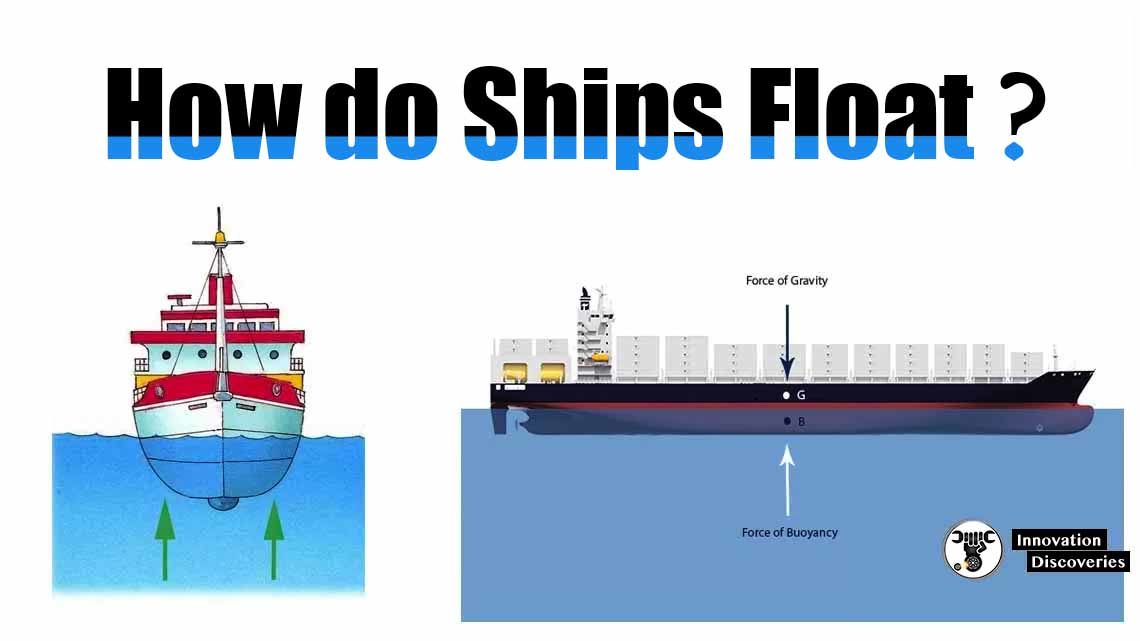
Count Shots of Anchor Chain
Because there is no two-drink minimum at sea
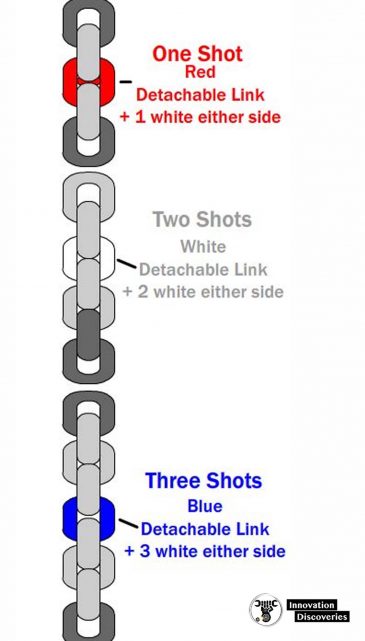
How to Count Your Shots
-Anchor chain is measured in shots.
-Each shot is 90ft or 15 fathoms long.
-The linkages between shots are marked so that the exact number of shots let out can be ascertained at any time.
-The markings consist of a number of chain links painted in different colors, and a series of wires wrapped around the “detachable link.”
-At the One-Shot mark, one link on either side of the detachable link is painted white, and one turn of wire is wrapped around each stud.
Traditionally, the detachable link at One-Shot is painted red, though this practice is not always observed.
-At the Two Shot mark, two links on either side of the detachable link are painted white, and two turns of wire are wrapped around each stud.
This detachable link is traditionally painted white as well. From there on, an additional link is painted on either side of the detachable link for each additional shot.
-Also, at the Three Shot mark, the detachable link is painted blue, at Four it’s red, at Five it’s white, and the pattern continues on, red-white-blue.
–On the TSGB, there are two anchors, one port, one starboard on the bow. Each has about 10 shots of chain attached (10 shots = 900 ft).
The second to last shot is painted entirely yellow. Why?
Because if you see that yellow chain coming out of the spill pipe fast and the anchor still hasn’t hit the bottom, you want to get the hell out of the way because the chain likely won’t stop running by braking alone.
-Likewise, the last shot is painted entirely red. If you see red, run, or you’re dead. Cheers!
-The location of the marking is also important to note when lowering or raising the anchor chain as a reference point is needed in order to measure the length of the chain in the water.
-The marking can be said to be “On Deck” when the marking is at the top of the hawsepipe, or “On the Water” when the marking is just above the water.
If asked how many shots are out, always give a reference point, even if that reference point doesn’t sound official.
Saying “On the Windlass” when the mark is at the crest of the windlass or “At the top of the hawsepipe” is usually perfectly acceptable.
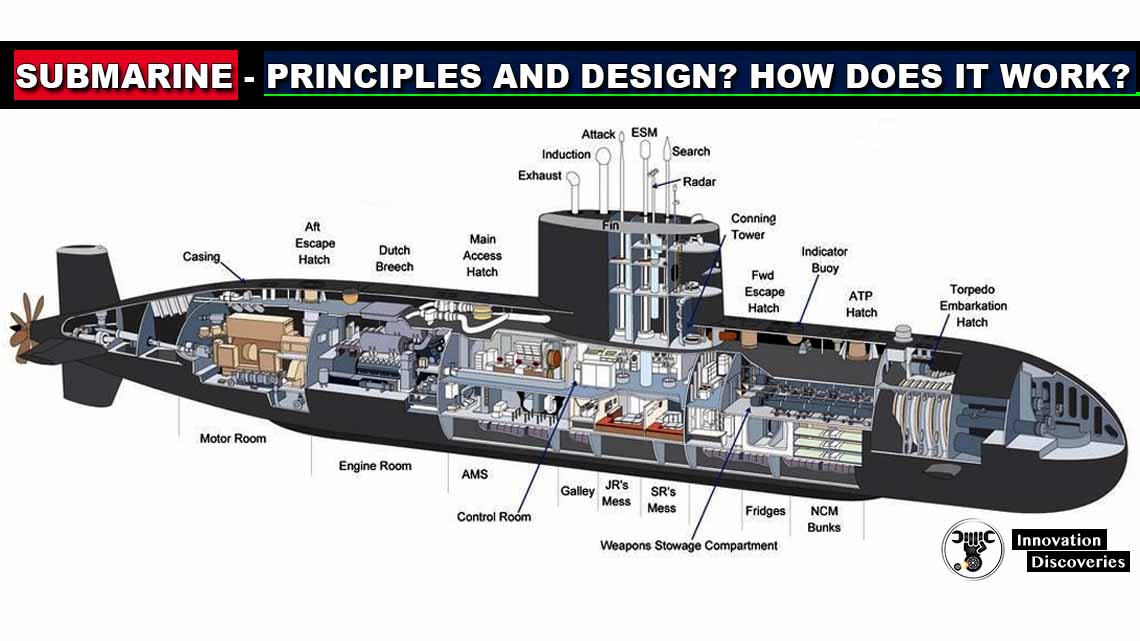
Visit Forum
Visit Our Friendly Website



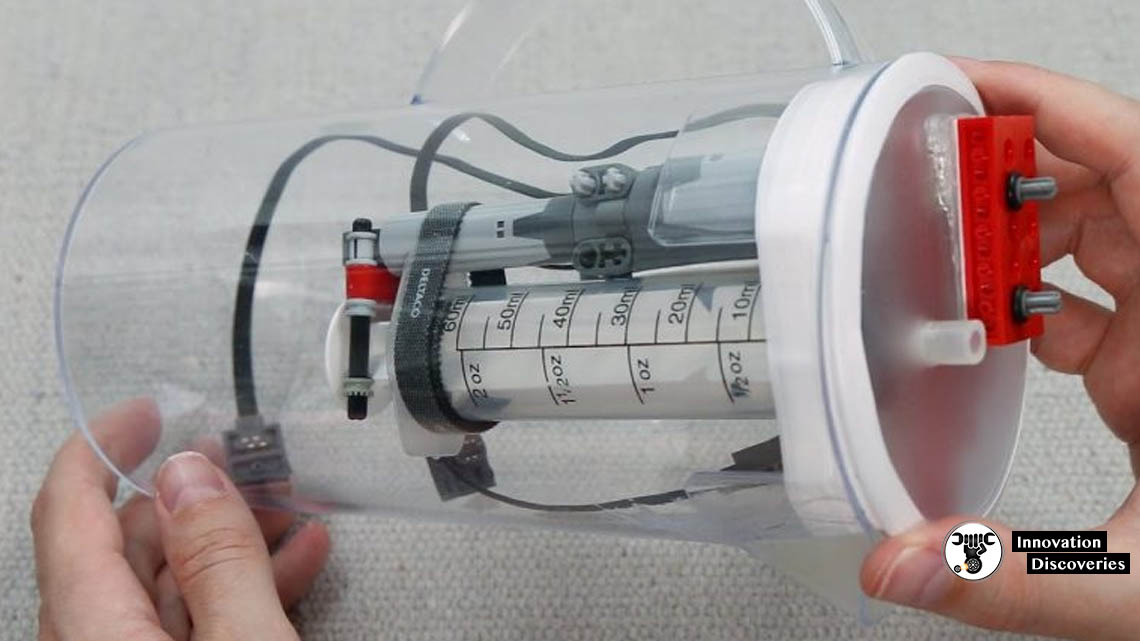

One Comment